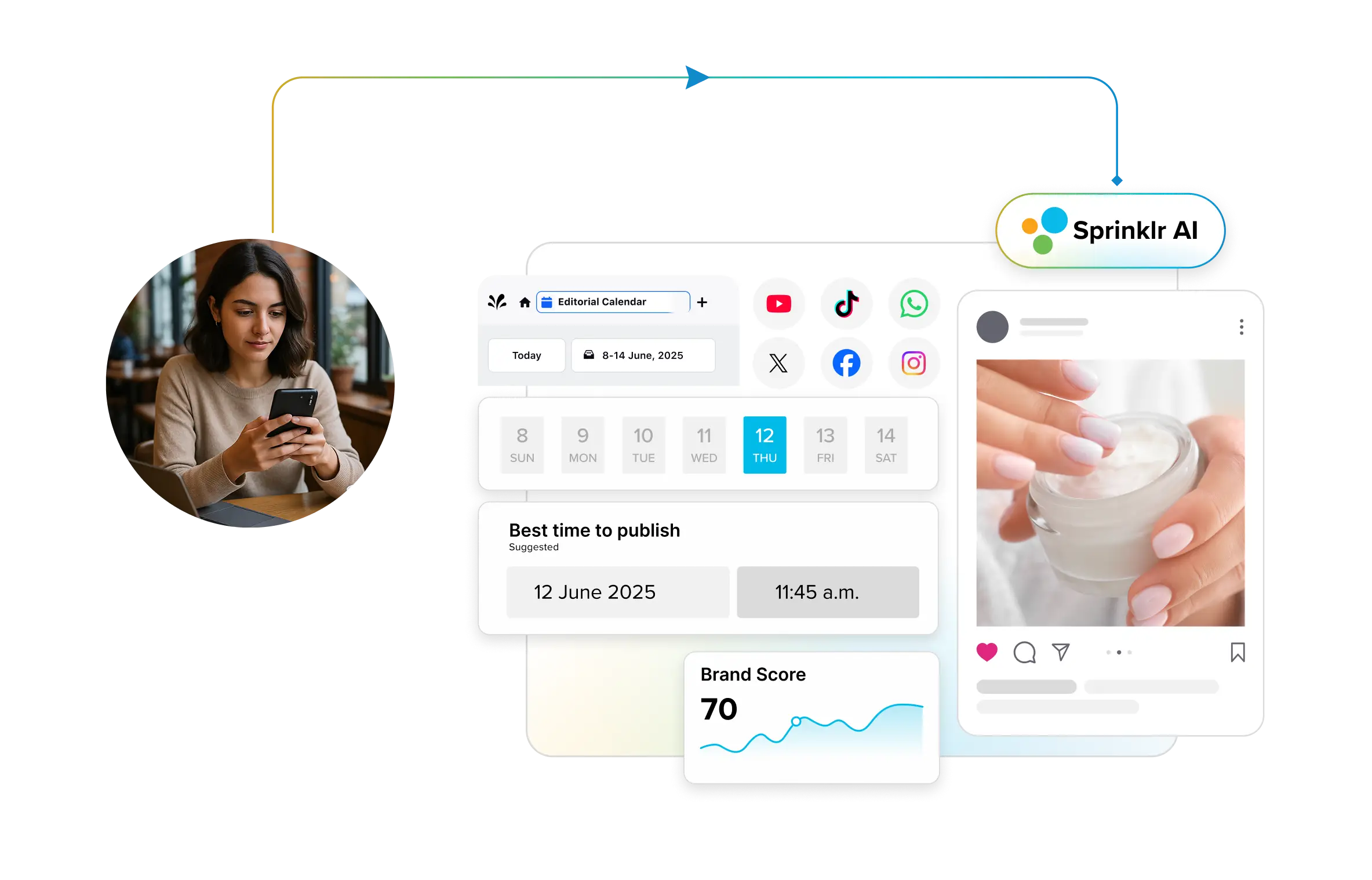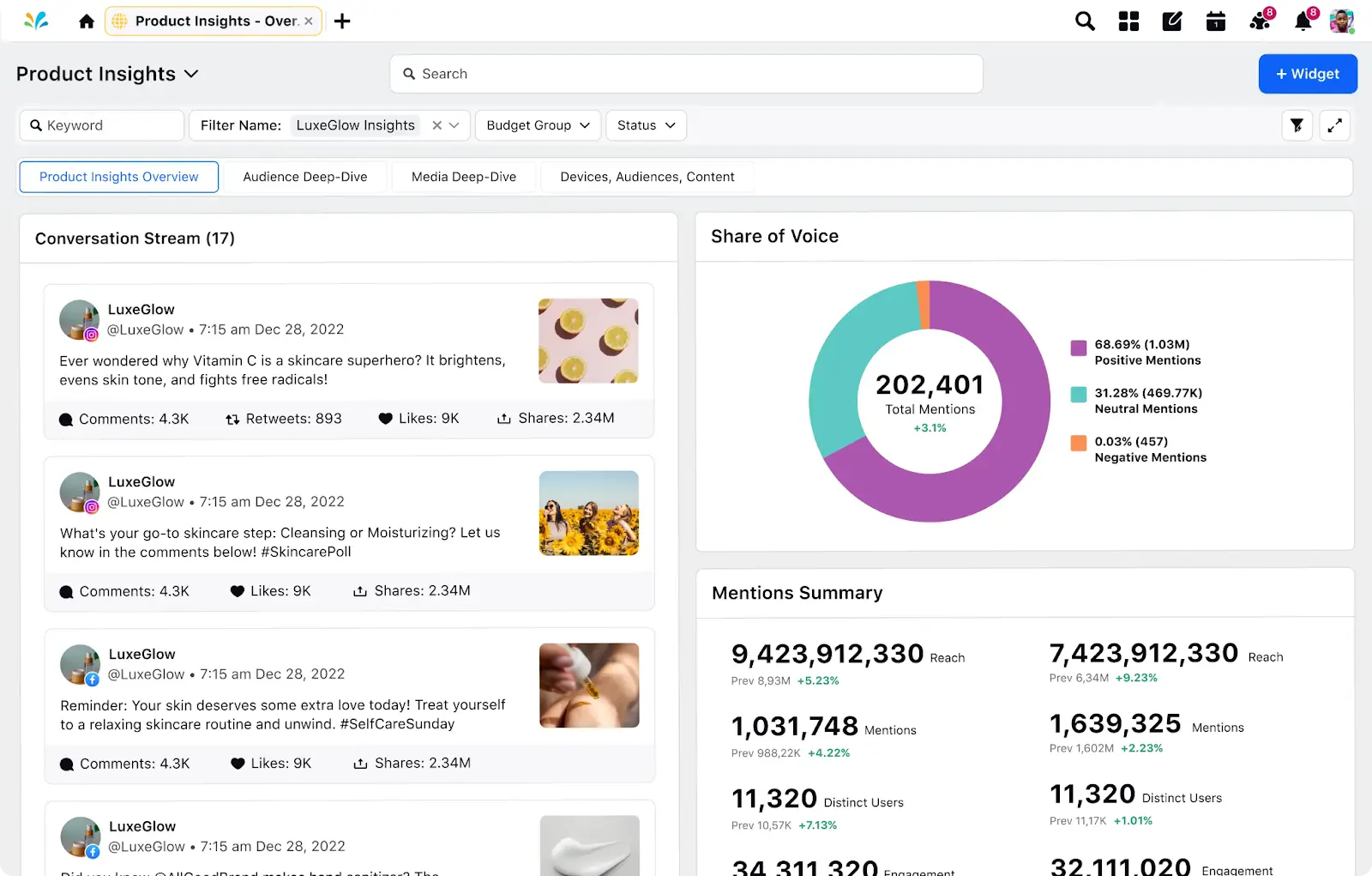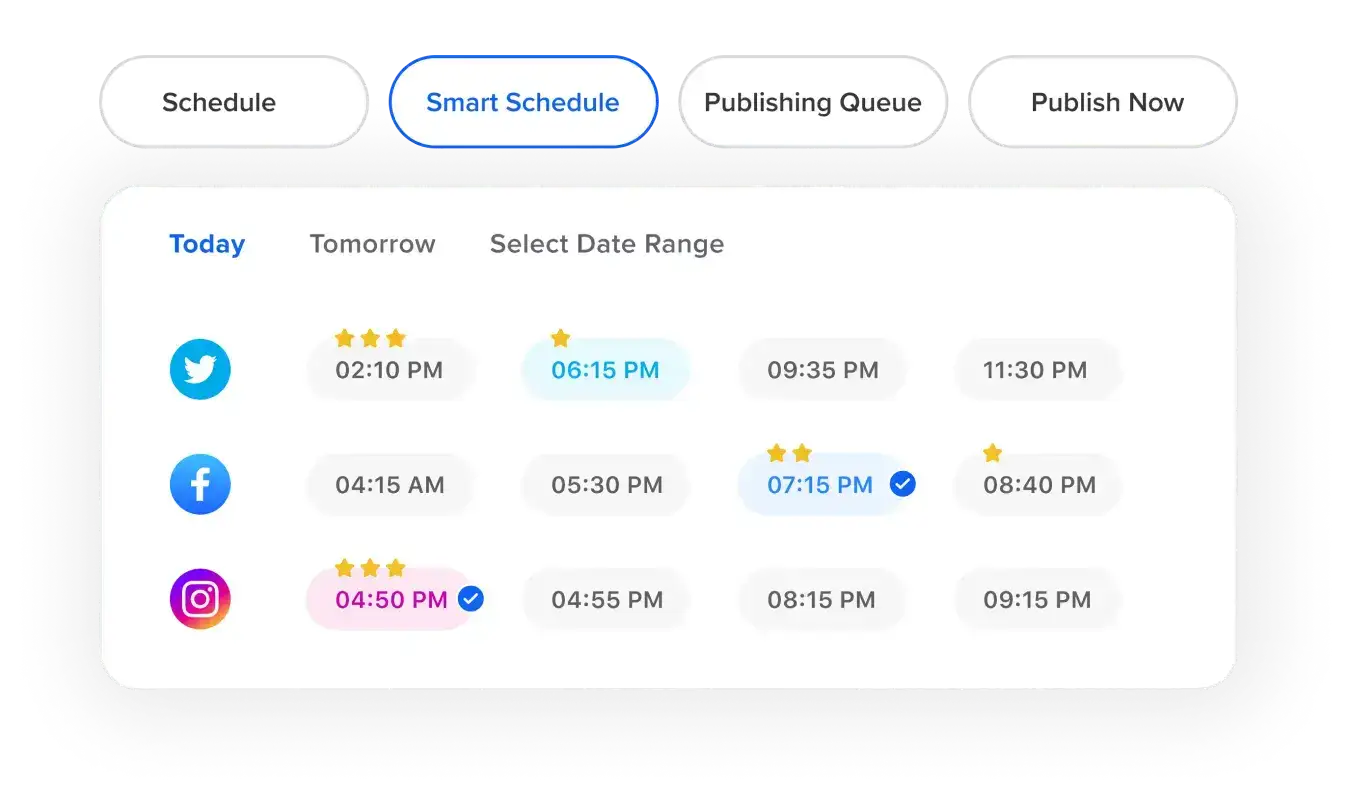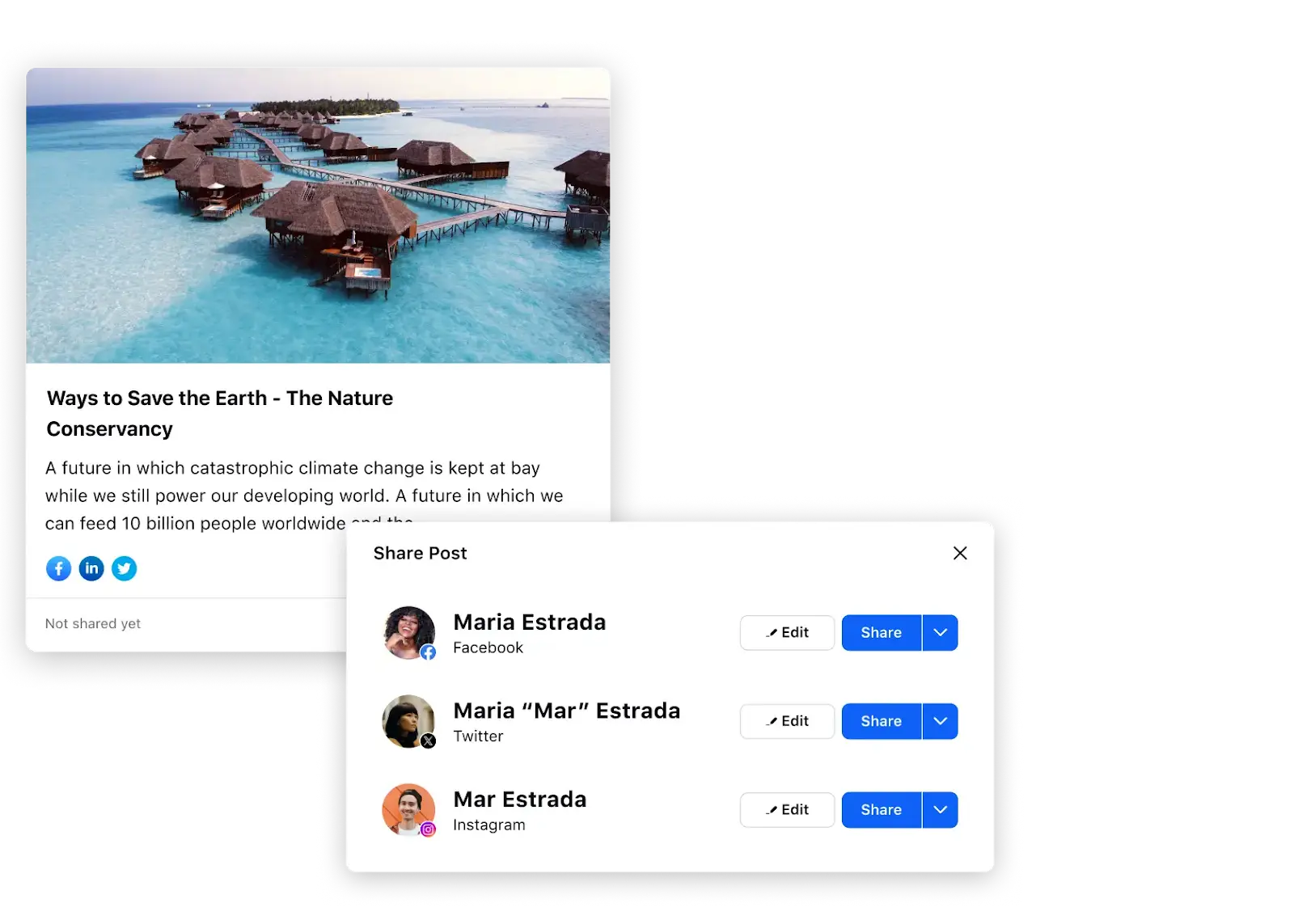The global leader in enterprise social media management
For over a decade, Sprinklr Social has helped the world’s biggest brands reimagine social media as a growth driver with a unified platform, industry-leading AI and enterprise-grade scale.

Social Media Manager vs Community Manager: Similarities and Differences
Have you ever stumbled upon a brand on social media that truly “gets” you? They respond to your witty comments with equally clever responses, pay attention and appreciate your personality and post content that relates to your world. Well, this does not happen by chance. It's driven by a dedicated social media team, particularly the social media manager and the community manager, who serve similar yet distinct purposes.
Reports suggest that 90% of users follow at least one brand on social media. What’s more, 70% of consumers with positive social experiences will likely recommend the brand to friends and family. Compelling statistics, right? Given the undeniable power of social media to build brand loyalty and drive growth, let’s look at how social media managers and community managers contribute to this goal.
In this blog, we’ll be learning the key similarities and differences between these roles, sharing examples and discussing how businesses can effectively deploy social media and community managers to grow.
Think of your online community as a bustling city. The social media manager is like the city planner — they decide the layout and design of public spaces. The community manager is like the city mayor — they ensure everyone feels welcome, address concerns and foster connections. Makes sense so far? Now let’s explore each of their roles and responsibilities in detail.
What is a social media manager?
A social media manager is the person behind the brand’s voice and personality on social media. They create, curate, and share content that resonates with their audience while ensuring the brand voice remains consistent across social media platforms. They cultivate connections with people familiar with the brand to foster loyalty and build an online customer community.
For example 💫: Imagine MAC Cosmetics is launching a new limited-edition makeup line inspired by a renowned artist. Their social media manager might create and post visually stunning campaigns, reels featuring influencers, behind-the-scenes snippet videos and interviews with the artist.
A social media manager wears many hats and balances data, strategy and creativity. Let’s break down what it takes to excel at this role:
Key responsibilities of a social media manager
- Content creation: Crafting and producing engaging content, such as text, images and videos tailored for each platform.
- Content scheduling: Managing social media posting schedule to publish posts regularly.
- Community engagement: Responding to comments and messages as the brand.
- Analytics and reporting: Monitoring social media metrics to generate reports on social media performance.
- Strategy development: Creating and executing social media strategies to improve follower count and engagement.
- Trend monitoring: Staying up to date with industry trends, platform changes, algorithm improvements and other best practices.
- Collaboration: Coordinating with other departments for consistent brand messaging.
Core skills of a social media manager
- Creating engaging content: The ability to create compelling and visually appealing content tailored to each platform's demographics and format. They should be able to think resourcefully to develop innovative campaigns that stand out in a crowded digital landscape.
- Analytics and data interpretation: Proficiency in analyzing social media metrics to measure campaign effectiveness and derive actionable insights.
- Strategic planning: The capability to develop comprehensive social media strategies aligned with overall marketing goals. They should be able to adapt quickly to new social media trends, tools and platform updates.
- Communication: The skill of communicating clearly and concisely with internal and external stakeholders, influencers, PR, and ad agencies by crafting captivating messages.
- Project management: The ability to manage multiple campaigns, timelines and deliverables simultaneously.
- Customer service: Proficiency in providing excellent social media customer service, addressing inquiries and handing them off to the right team.
Dive Deeper: 9 Skills Every Social Media Manager Needs for Success
Now that we have seen the skills and responsibilities of a social media manager, let's examine a few tools that help them bring their strategies to life.
Tools used by social media managers
- Content creation and design tools like Adobe Creative Suite and Canva
- Software to cross-post and schedule social media posts
- Analytics and reporting software like Google Analytics
- Engagement and community management software
- Tools like BuzzSumo and Sprinklr for trend analysis and research
- Social listening tools to be familiar with customer sentiment around the brand and its products
Read More: Social Media Management: Key Benefits and Strategies
💡 Pro Tip: Social listening is the Swiss army knife of social media tools
Engagement isn’t just about responding quickly and thoughtfully to comments; it’s about understanding the conversations happening within your brand’s sphere of influence. This is where Sprinklr’s Social Listening solution steps in.
It’s a powerful tool designed to help you monitor and respond to social media conversations in real time. Here’s how it can help:
🔎 Centralized monitoring: Aggregate comments, mentions and messages across multiple platforms into one easy-to-manage dashboard, ensuring you never miss important interactions.
🚨 Real-time alerts: Get instant notifications for key conversations and social media mentions to respond quickly and thoughtfully to your audience.
📊 Sentiment analysis: Understand the tone and sentiment of the conversations around your brand with sentiment analysis to tailor your responses to be more empathetic and effective.
🚀 Enhanced efficiency: Streamline your social media management by prioritizing responses based on importance and influence, ensuring you engage with high-impact conversations first.

What is a community manager?
A community manager is the brand’s ambassador. They are the driving force behind the brand’s online presence and engaging with the community on a personal level. They use their own social media accounts to participate in discussions, gather feedback and build relationships through customer engagement. They interact with existing and potential customers and create a highly engaged community of brand loyalists.
Community managers create a sense of belonging and trust by listening to feedback and advocating for the brand.
For example 💫: Remember the MAC Cosmetics case we touched on earlier? For the same limited-edition makeup line in collaboration with a renowned artist, the MAC community manager will engage with customers by answering their queries, conducting surveys and curating user-generated content (UGC). They will engage with customers not just on social media platforms but also on discussion forums like Beautylish, Sephora Community, Reddit and MakeupAlley.
Key responsibilities of a community manager
- Community moderation: Ensuring discussions on online forums, discussion boards, social media groups, e-commerce platforms and other communities remain respectful by enforcing platform and brand guidelines.
- Discussion and event activation: Sparking conversations and encouraging engagement by posting relevant and thought-provoking content. They are also required to plan and execute online and offline events to strengthen the community.
- Activity and crisis management: Keeping track of community dynamics to identify trends, issues and opportunities for improvement. They are also expected to handle conflicts and crises to maintain a positive community.
- Advocacy and relationship building: Advocating for the brand within the community, building relationships with supportive members and turning them into brand advocates.
- User-generated content cultivation: Motivating users to share their testimonials, reviews and photos of the brand’s products.
- Customer engagement and feedback collection: Gathering insights from community members to improve product development and marketing strategies. They are expected to build relationships by responding to comments, messages and feedback.
- Performance analytics: Analyzing customer engagement metrics and reporting on growth and sentiment.
Here's an example of a community manager's role — a post and reply from MacroFactor’s director of content on the brand’s subreddit account:
Core skills of a community manager
- Community engagement: The ability to foster a sense of belonging and loyalty within the community through active participation and meaningful interactions. They should build and nurture relationships with community members, influencers and stakeholders to support growth and collaboration.
- Event planning and coordination: Skilled in organizing and managing community events, both online and offline, to enhance engagement and build stronger relationships.
- Content moderation: Expertise in monitoring and moderating user-generated content to ensure it adheres to community guidelines and maintains a positive environment.
- Crisis management: The ability to handle community crises, such as conflicts or negative feedback, swiftly and effectively to protect the community's integrity.
- Brand advocacy: Skilled at representing the community's interests and needs to internal stakeholders, and advocating for features, improvements or changes based on community feedback.
- Customer feedback collection: The ability to gather and synthesize feedback from the community to inform product development, service enhancements and overall strategy.
- Community strategy: Ability to design and implement programs that drive community engagement, such as ambassador programs, loyalty rewards or user-generated content initiatives.
Tools used by community managers
- Customer relationship management software
- Engagement and community management software
- Analytics and reporting software
- Design tools like Adobe Creative Suite and Canva
- Tools like BuzzSumo and TrendSpotrr for trend monitoring and research
- Bulk email software if you want to take your community to another medium
Explore More: How to Build an Effective Community Management Strategy?
Pro-tip for the win🥇
Your social media and community managers should collaborate often. For instance, a community manager stays attuned to the audience's questions and concerns. The social media manager can then use this information to determine what content to create.
For instance: Say you run a tech company and are launching a new smartphone. Your community manager notices a surge in questions surrounding battery life. He tells the social media manager about this, who then creates content around your smartphone's battery life and adds battery-saving tips. This synergy between the community and social media manager leads to content that meets the needs of your consumers.
The similarities between social media manager and community manager
While there are nuanced distinctions, there exists a significant level of collaboration between the roles of social media manager and community manager. Their convergence and understanding of shared responsibilities can contribute to formulating an effective social media strategy.
#1: Social listening
Both social media managers and community managers spend significant time monitoring conversations across various social media platforms. Social listening helps them track trending topics, brand mentions and customer feedback.
Social media managers use this information to create social media strategy, while community managers use these insights to engage with the community directly.
#2: Content creation and planning
Social media managers create and plan content for the brand. They curate and schedule posts, ensuring consistency with the brand’s voice and strategy.
Community managers also contribute to social media content creation, especially when it comes to community-specific content from their own accounts. They may also share user-generated content, host live chats or create community-focused posts.
Consistency is key to building a strong social media presence. Scheduling your posts in advance not only ensures regular engagement with your audience but also allows you to maintain a cohesive brand voice and strategy across all platforms.
A comprehensive tool like Sprinklr’s Social Media Content Scheduler will help you streamline your approach to managing your content calendar. It centralizes all your scheduling needs for 10+ social channels and helps in publishing content at AI-recommended times for each platform, ensuring consistent and timely content delivery.

#3: Metrics and data analysis
Both roles rely on data to measure success and optimize their efforts. Social media managers track metrics like engagement rates, reach and conversions, while community managers assess community growth, customer sentiment and participation.
#4: Digital savviness
Both social media and community managers must stay current on social platform trends and platform features. They must adapt to social media algorithm updates, explore new tools and understand platform-specific content requirements.
#5: Brand advocacy
Both community managers and social media managers champion the brand. Social media managers advocate for the brand through content strategy and creation. The community manager does the same by addressing customer concerns through positive interactions, aiding community development. Community and social media managers also regularly leverage another valuable resource to amplify brand reach: your employees.
🏆 Champion employee advocacy for brand success
Social media and community managers are not the only internal touchpoints for brand communication. Your employees can also share company content on their personal social media.
However, creating a process that makes it easier for them to share content can be challenging. Your HR team can create guidelines and periodically remind employees to share content. But this is a tedious exercise that isn’t always effective.
Make it easier for everyone involved by leveraging Sprinklr’s Employee Advocacy Platform. Here’s how it helps:
- Centralized content hub: Sprinklr Advocacy provides a single repository for all shareable content, making it easy for employees to find and share the latest content.
- User-friendly interface: The intuitive interface ensures that even employees who are not social-media-savvy can navigate and share content with just a few clicks.
- Automated reminders: Automated notifications keep employees informed about new content, encouraging regular sharing without requiring manual prompts from HR.
- Gamification: Incorporate leaderboards and rewards to motivate employees to participate actively in content sharing and foster a sense of competition and engagement.
- Compliance: You can ensure that all shared content complies with company policies and industry regulations, safeguarding your company’s reputation and reducing the risk of platform violations.

The differences between social media manager and community manager
While there is some overlap, social media managers and community managers have distinct focus areas. This neat little table explains more:
Aspect | Social media manager | Community manager |
Overarching responsibilities | - Posts as the brand’s account on social networks - Responsible for content creation and replies to customer inquiries and comments - Ensures posts align with the brand’s voice and strategy | - Posts as a brand ambassador from their own account and not the brand’s account - Develops community by participating in discussions and finding prospective customers - Advocates for the brand |
Audience focus | - Engages with people who are already familiar with the brand - Primarily deals with existing followers | - Connects with potential customers within the online community - Advocates for the brand beyond existing followers |
Social persona | - Represents the brand’s voice - Maintains consistency in tone and messaging | - Creates an individual voice, making the brand more approachable - May have a separate social account linked to the brand |
Platform focus | - Works mainly with forward-facing social platforms of the brand | - Engages across various platforms, including social media platforms, forums, groups and niche communities |
Content strategy | - Strategizes content creation for the brand - Listens and responds to engaged followers | - Advocates for the brand and community - Focuses on community-specific content |
Skills required | - Content creation, scheduling and social strategy - Customer service and marketing skills | - Relationship-building, community engagement and active listening - Advocacy skills |
Success metrics | - Tracks engagement rates, reach, conversions and brand sentiment | - Measures community growth, sentiment, participation and brand advocacy |
Company fit | - Typically a part of the marketing team | - Often bridges marketing, customer support and community development |
Social media managers vs community managers: Why both are important
Social media managers and community managers are like the yin and yang of your business strategy. Social media managers attract audiences through content creation and once the audience arrives, the community manager takes over and nurtures a sense of belonging within the community. This engaged community helps retain existing customers and attract new ones through brand advocacy and word-of-mouth.
Community managers bring the human touch and understand the nuances of social media interactions. This allows them to identify potential brand advocates, which in turn helps social media managers leverage them to spread brand awareness. So the roles of social media manager and community manager are not interchangeable; they are complementary.
The bottom line
Social media managers focus on brand content and presentation, ensuring consistent platform messaging. Community managers act as brand ambassadors, engaging in discussions, connecting with potential customers and advocating for the brand. Together, they navigate challenges such as evolving trends and algorithms, measuring social media impact, creating engaging content and balancing brand messaging with authentic relationship-building.
Be it a social media manager or community manager, they need to meet social media KPIs, and here, Sprinklr can better align community and social media management roles and drive growth at scale. Want to find out how?
Frequently Asked Questions
Decide based on your goals. If growth is your goal and you have not gained enough social media traction, get a social media manager first. If your goal is engagement (you already have a significant following), get a community manager to build community, monitor sentiment and manage relationships.
While possible, it’s challenging due to the distinct skill sets and time commitment each role requires. You may not achieve your goals if a single resource handles both portfolios.
Companies often fail to actively engage with community members, leading to:
- Lack of customer participation
- Missed opportunities for improvement and innovation
- Diminished interest and engagement from members
Reassess your social media and community management strategies quarterly to ensure they align with your business goals and industry trends. This helps you stay responsive to changes in audience behavior and algorithms.
Sprinklr Social streamlines tasks by offering comprehensive social media management features, including content scheduling, analytics and customer engagement tools. These benefit both social media and community managers.








